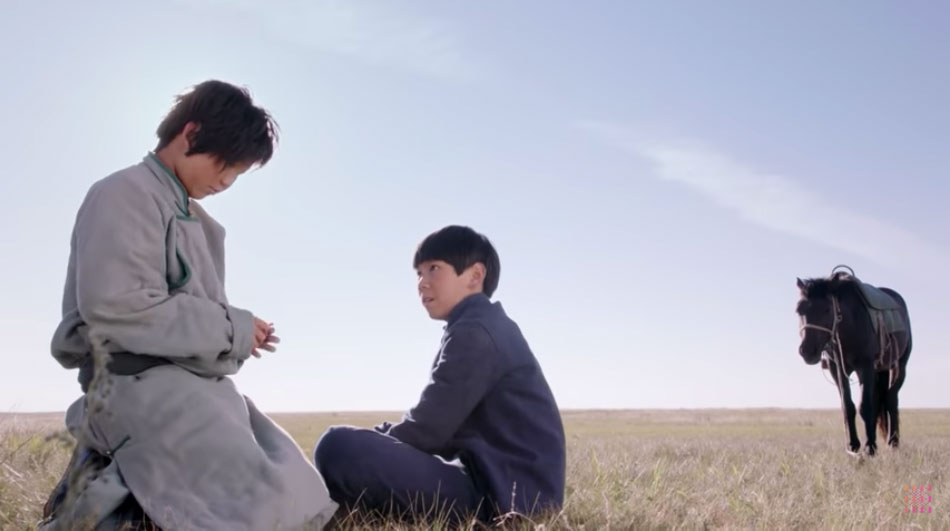ON 17 SEPTEMBER 2019, President Xi Jinping signed a presidential decree to award National Medals 国家勋章 and National Honors 国家荣誉称号 to forty-two people on the occasion of the seventieth anniversary of the founding of the People’s Republic of China (PRC). Among them was an ethnic Mongol woman, Duguima 都贵玛, from Inner Mongolia, who won the honorary title of People’s Model 人民楷模. According to Xinhua, this medal
symbolises the major contributions made by the winners in various fields and industries and the exemplary role they play in inspiring the people of all nationalities in China to remain true to our original aspiration and keep our mission firmly in mind, and to struggle ceaselessly to realise the Chinese dream of the great rejuvenation of the Chinese nation ’1
At the awards ceremony, held in the Great Hall of the People in Beijing on 29 September, Xi personally awarded Duguima her honorary title and medal.
Duguima was born in 1942 to a herder’s family in a rural community in Dorbod Banner 四子王旗 in Inner Mongolia. When she was nineteen years old, her fate became intertwined with a group of Shanghai orphans. From the late 1950s to the early 1960s, China experienced a catastrophic famine, which resulted in the deaths of tens of millions of people. Parents in the provinces surrounding Shanghai who were unable to feed their children brought them into the city and abandoned them — with the total numbering in the tens of thousands. With Shanghai’s food supply already under enormous pressure, Kang Keqing 康克清, then chairman of the National Committee for the Defence of Children, appealed to prime minister Zhou Enlai 周恩来 for help. Zhou discussed the issue with Ulanhu 乌兰夫, chairman of the Inner Mongolia Autonomous Region, who agreed to move 3,000 orphans to Inner Mongolia. These children, ranging in age from a few months to seven years, were sent in waves to several banners2 and counties in Inner Mongolia between 1960 and 1961. The local government of Dorbod banner assigned Duguima to its nursery school to look after twenty-five orphans before they could be adopted by local families.
For many years, the Party-state has promoted the story of how Inner Mongolians cared for the Shanghai orphans as a model of love, national unity, and patriotism. At the time of the fiftieth anniversary of the founding of the Inner Mongolia Autonomous Region in 1997, Ma Li 马利, then a journalist and deputy director of the domestic political department of the People’s Daily, wrote a widely read piece titled ‘Three thousand orphans and prairie mothers’ 三千孤儿和草原母亲. Zhang Jinxi 张锦贻, director of the Literary and Art Theory Research Office of the Institute of Literature of the Inner Mongolia Academy of Social Sciences, commended Ma Li:
This is reportage of national and historical significance. It lets the people of all ethnic groups … know the meaning of the ‘big family of the motherland’ 祖国大家庭 and the ‘national unity’ 民族团结.3
Inspired by Ma Li’s work, the famous Mongolian director Ning Cai 宁才 filmed a sixteen-episode TV series, The Silent Emin River 静静的艾敏河, about the ‘prairie mothers’ and the Shanghai orphans. The national channel CCTV 1 broadcast the series in 2002. In 2009, Ning Cai filmed the related film, My Mongolian Mother 额吉, which was selected as a key ‘tribute’ film 国庆献礼片 for the sixtieth anniversary of the founding of the PRC. In 2019, for the seventieth anniversary, the State Administration of Radio, Film and Television selected the 2018, forty-episode TV series on the same subject, National Children 国家孩子, by director Baatar 巴特尔 (whose mother is Mongolian and father is Han Chinese).
For all the prominence given to the story of the orphans and their ‘prairie mothers’, many questions remain. The Party-state maintains that the extreme shortage of food in China from 1959 to 1962 was caused by natural disasters. In contrast, independent scholars in China and overseas highlight the role of Mao’s Great Leap Forward, which, combined with the withdrawal of Soviet aid and natural disasters, led to economic chaos and industrial and agricultural collapse. Other questions persist about the famine’s total death toll; estimates range from four million to thirty million. The total number of Shanghai orphans is another mystery. According to a reporter for the Southern People Weekly 南方人物周刊, Wu Congling 吴聪灵, there were at least 50,000 orphans. Children were sent not only to Inner Mongolia, but also to Shandong, Shanxi, Henan, Hebei, Shaanxi, Jilin, Xinjiang, and other places.4
According to a 2015 CCTV news report, less than one percent had the opportunity to reunite with their biological families in later life.5 Most step-parents have been unwilling to tell the truth to the orphans, while many orphans have not actively looked for their own biological parents because of not wanting to hurt their step-parents. In many cases, orphans started the search for their biological parents after the death of their step-parents, although, because they lack detailed birth records, this has proven very difficult. Some have used newspapers and online platforms, and some have visited Shanghai, Zhejiang, and Jiangsu to find their relatives. While a small number of orphans had bodily markings, such as tattoos and ear-cuts, left by their biological parents, most have had to rely on observations of facial similarity to make preliminary matches, followed by DNA testing to determine relationships. In recent years, the average age of orphans has reached sixty, and most of their biological parents are no longer alive, leaving them only with the hope of meeting their brothers and sisters. Duguima may have been a People’s Model in her ‘ceaseless struggle’ to support these orphans in times when rejuvenation of the Chinese nation was just a very remote dream. For many of the orphans themselves, reuniting with their birth families remains a distant dream to this day.





